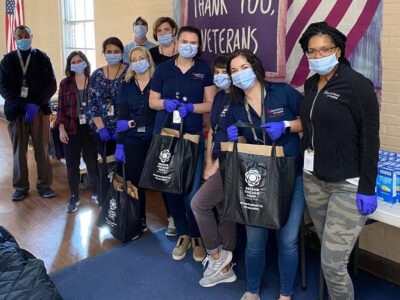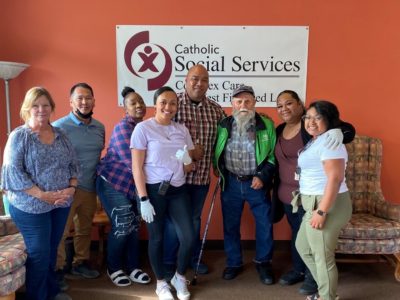Housing and health are closely linked, but the systems responsible for improving these outcomes often operate separately. This means that individuals at risk of homelessness or experiencing homelessness might not receive the vital health and housing assistance they need, depending on which system they are navigating. If these gaps are not addressed, people may struggle to break free from a cycle that perpetuates housing instability and poor health.
The key lies in collaboration between these systems. Communities have shown that when these systems come together, they can ensure that unhoused neighbors receive coordinated care that addresses their health needs and connects them with housing support to help maintain their health.
In the Greater Hartford area of Connecticut, a critical component of creating that bridge was developing and hiring for the role of a health care liaison. These liaisons play a pivotal part in building relationships, designing efficient processes, and improving coordination, experiences, and outcomes for people experiencing homelessness. As a part of the Built for Zero network focusing on upstream strategies to end homelessness, Journey Home, a systems change agency serving the Greater Hartford geographic area, recently advocated for and hired a health care liaison to serve within their homeless response system.
Journey Home, the backbone organization for two geographical areas in Connecticut that support the coordinated entry system, called the local Coordinated Access Network (CAN), is a natural fit for this position as hospitals and homeless service providers were already calling Journey Home for emergency response.
“We overwhelmingly kept hearing from our providers both in the housing and health care side that support was needed for the population as they were aging and presenting with increased medical and behavioral health needs,” explained Sarah Pavone, Director of Strategy for Journey Home.
“Our data was also showing this. Historically, the housing and health care system was kind of patchworked together, so we responded to this need by creating the homeless medical liaison position.”
Often, when an individual is identified within a hospital as at risk of or experiencing homelessness, there is no formal process to follow to connect that individual to services. Having a dedicated liaison position creates a known point of contact for referral to housing or other support services.
Pavone noted, “The hope was to build a bridge between the health care and housing system — that it would create relief for not only the folks we’re serving, but also our providers that were in need of assistance.”

“The hope was to build a bridge between the health care and housing system.”
— Sarah Pavone
Meeting a need and filling a gap through the liaison role
A health care liaison is a dedicated role typically employed and managed by the local Continuum of Care (CoC) or homeless response system. A liaison’s primary responsibility revolves around engaging with the local health care system(s) and strengthening the relationship between the two entities.
By collaborating with key players such as the coordinated entry lead or outreach manager, a liaison can ensure coordination and linkages to housing, ultimately improving outcomes for people experiencing homelessness.
They support clients in reviewing their eligibility for housing opportunities, enroll them in relevant housing programs, and help them access public insurance offerings like Medicaid and Medicare. They also can enhance outreach efforts by centralizing communication and planning for the health care system.
In the local context of Hartford, homeless response leaders recognized this position was necessary to meet a need and fill a readily apparent gap between these two systems. In forming this role, the CoC partnered with one hospital to receive referrals from their electronic health records, focusing on high utilizers, who are clients with higher rates of hospitalization and emergency department use compared with the broader population.
“We have full access to caseloads and capacities, and we act as the fiduciary for a lot of funding,” Pavone explained. “We’re able to have full access to our HMIS system, so we’re able to look up who is connected to this patient, who isn’t. And now having a strong relationship with the hospital that’s grown drastically since Covid, getting access to their EHR system has really just linked everything together for this role to be even more successful.”
No blueprint for laying the groundwork
Journey Home’s development of the liaison role has been “very organic in nature,” according to Pavone, due to restricted resources and a lack of a blueprint for their community to follow. With limited funding, Hartford needed to build relationships and lay the groundwork within only a few months.
Journey Home’s health care liaison, Autym Pollard, began in this new role in early 2023 and has had to navigate several structural issues in her work.
“Some of what I’ve been encountering are just getting providers to improve care coordination for clients,” Pollard said. “We did host a provider meeting to get everyone on the same page in terms of coordinating that care once the client either discharges from the hospital or needs housing services.”
By aligning with important health care partners, health care liaisons can demonstrate that the homeless response system recognizes health care access as a significant aspect of health equity. This fosters timely and personalized referrals, strengthening trust between people experiencing homelessness and the health care system.

“Communities should continue to seek and improve their understanding and their overall knowledge on the complex barriers that our patients are facing in navigating health care services.”
— Autym Pollard
Counterpart to the health liaison: the homelessness liaison
A homelessness liaison is a role primarily hired and managed by the local health care system or hospital. They focus on identifying and engaging with patients at risk of or experiencing homelessness and building solid relationships with the local homeless response system. This type of liaison position works closely with hospital social work roles such as case managers, discharge planners, or community health workers to coordinate referrals to available housing resources.
Pavone stresses the importance of having these cross-sector roles and the valuable knowledge gained from them. “We really needed to learn how to access services and just learn from each other’s systems — even learn each other’s languages,” she said. “A big disconnect was just not understanding the language from each system.”
The presence of homelessness liaisons within the health care system can demonstrate a commitment and accountability to generate solutions and allocate resources for homeless populations. This also shifts the sole responsibility from the homeless response system.
As Pollard noted, “Communities should continue to seek and improve their understanding and their overall knowledge on the complex barriers that our patients are facing in navigating health care services.”
“There’s obvious things like transportation and insurance, but then we also should consider socioeconomic status, an individual having a comorbid status, or not being able to utilize shelter services because they fear infection transmission, especially if they’re a client who was just in the emergency department,” she said. “I think doing so will allow an opportunity to see the total need for the liaison role.”
How to advocate for a liaison role
The liaison role, whether in health care or homelessness, is critical in bridging gaps, building relationships, and improving outcomes for individuals experiencing homelessness. By fostering collaboration, liaisons ensure that individuals receive timely and appropriate care while addressing the social determinants of health contributing to homelessness.
While funding these liaison roles can be a significant barrier for communities to begin, experienced leaders like Pavone compels communities to be tenacious advocates.
“Be very vocal about funding, because funding these positions is really hard,” Pavone said. “It’s important to have honest conversations with stakeholders about why this funding is needed to have an impact.”
Despite these challenges, health care and homelessness liaisons can significantly influence the lives of vulnerable populations, demonstrating the importance of coordination and partnership in creating a more equitable society.
“As you want to plan, at some point you just dive in feet first and figure it out,” Pavone said. “As long as you go forward with intention and have the partnerships, just move forward. Just go for it and you’ll figure it out as you do it.”




